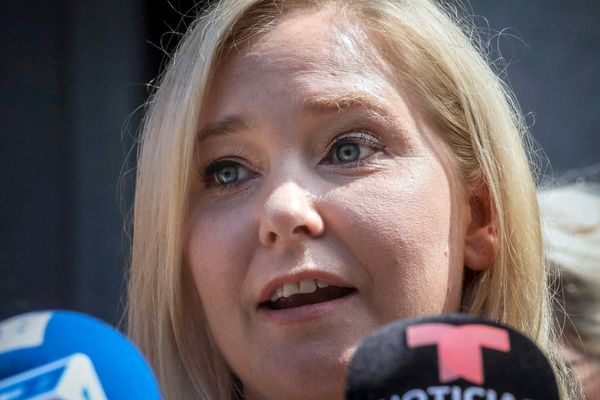
As parliament debated Labor’s bill to appoint administrators to the construction union last week, the Coalition repeatedly claimed the union was responsible for a 30% premium on construction costs.
Senior opposition members, including Peter Dutton, the shadow workplace relations minister, Michaelia Cash, and shadow assistant minister for home ownership, Andrew Bragg, referred to this as the “CFMEU tax”.
They blamed the Construction, Forestry and Maritime Employees Union for cost blowouts in major projects such as schools and hospitals, and contributing to poor housing affordability.
Here’s what you need to know about the claim.
What is the source for the claim?
Bragg told Guardian Australia on Thursday the figure came from the Master Builders Association. “That is their data, their figures, we’re comfortable in relying on their information,” he said.
The MBA’s apparent source is a 2024 report it commissioned from Queensland Economic Advocacy Solutions on the impact of the Construction, Forestry and Maritime Employees Union’s Queensland pay deals.
What did the report find?
By comparing Queensland union pay deals with the award, QEAS claimed that the use of union-negotiated clauses could add significant costs to projects, even excluding consideration of more generous pay rises in the union agreements.
These were estimated to be an additional 3.5% to the cost of an apartment at the “low” end of the spectrum, 18.2% for “medium application” of the clauses, and up to 33% with “high application”.
Clauses it identified that could drive up costs included: no overtime or weekend work, unless agreed to by the union; 26 set rostered days off each year; permission for one union meeting or activity of up to two hours each day; and environmental clauses relating to inclement weather, dewatering and lightning.
What is the worst-case scenario?
The report describes the “high” scenario as “maximum application” of the union clauses, which suggests it is a worst-case scenario.
The report does not say what assumptions were used for the low, medium and high-use scenarios. For example, it is unclear how many work days a year QEAS assumed would be interrupted by a two-hour union meeting.
Nick Behrens, the author of the report, told Guardian Australia the assumptions “come from actual project information” and CFMEU usage of provisions in 2023.
But he said providing further details might help the union identify “building companies that were involved in the preparation of the report”.
“The report relies on the establishment of theoretical but typical building projects.”
Guardian Australia asked Behrens, the MBA and Bragg if they could identify any projects where union deals had increased project costs by 30%.
Could the premium end up as profit for the builder?
The QEAS report advises that “when quoting for a project, it would be prudent for a company with the CFMEU Queensland EBA [enterprise bargaining agreement] to quote based on a high application of agreement provisions”, reflecting “a potential maximum possible risk”.
If a company followed this advice it would be adding 33% to the quoted project cost, then if the worst-case scenario does not eventuate, pocketing any difference between the projected and actual labour cost. So a chunk of the supposed 33% union premium would end up as profit for the builder.
“This is the very point of the report, ie about sharing of risk but also reward under fixed price contracts,” Behrens said.
What does analysis of NSW pay deals show?
A separate analysis of CFMEU 2024-27 pay deals in New South Wales prepared for the Master Builders by the construction consultancy Rider Levett Bucknall found they could add between 6.2% and 8.8% to the total construction cost of a $120m project in the first year.
The Rider Levett Bucknall analysis included wage increases, which were excluded from QEAS. The NSW pay deals delivered pay rises of 7% in 2024, followed by 5% a year for the remaining three years. This 22% over five years compares with 20% in Victoria and 26% in Queensland.
The report does not estimate the total addition to project cost over the life of the pay deal – as some elements will compound every year and others will not – but notes “a further increase on labour costs of 5% per annum and contributions and allowances results in further increases”.
What does the union say?
In a social media post the construction union national secretary, Zach Smith, said the claim it adds 30% to project costs is a “blatant lie”.
Smith said “30% is just roughly the difference between the average CFMEU EBA and the award which sets minimum wages and conditions.
“In no capacity does this take into account the fact that experienced, skilled construction workers working under a CFMEU EBA work to finish jobs on time and under budget.”
Smith also pointed to research from the Centre for Future Work’s professor Jim Stanford which concluded that “construction labour costs can account for only a very small share (under 10% on average in Australia) of home prices”.
What do QEAS and MBA say?
“The conclusion of the QEAS report was that excessive usage of provisions (for industrial coercion or other purposes) means that projects take significantly longer to build,” Behrens said. “What this means in reality is the project builder is paying more people for a significantly longer period of time.”
“Rightly or wrongly there is emphasis on the 33% but I also highlight that any cost difference could be as little as 3.5% through more moderated use of EBA provisions without touching pay rates or number of persons required for the project.”
The Master Builders dispute that 30% is the difference between a union pay deal and the award, noting that for some trades and classifications union pay rates can be 85% higher than award rates.
So what’s the reality of the claim?
The Coalition has claimed that the CFMEU adds 30% to project costs.
The QEAS report in relation to Queensland pay deals does not support such a claim. The QEAS report is a worst-case scenario, which finds that a “maximum” application of certain clauses could cause a 33% cost increase in circumstances which the author of the report will not reveal due to confidentiality of industry participants.
The CFMEU tax claim is unverifiable because it is not supported by examples of actual cost increases of that size and assumptions used to generate the estimate of 30% are not public.







